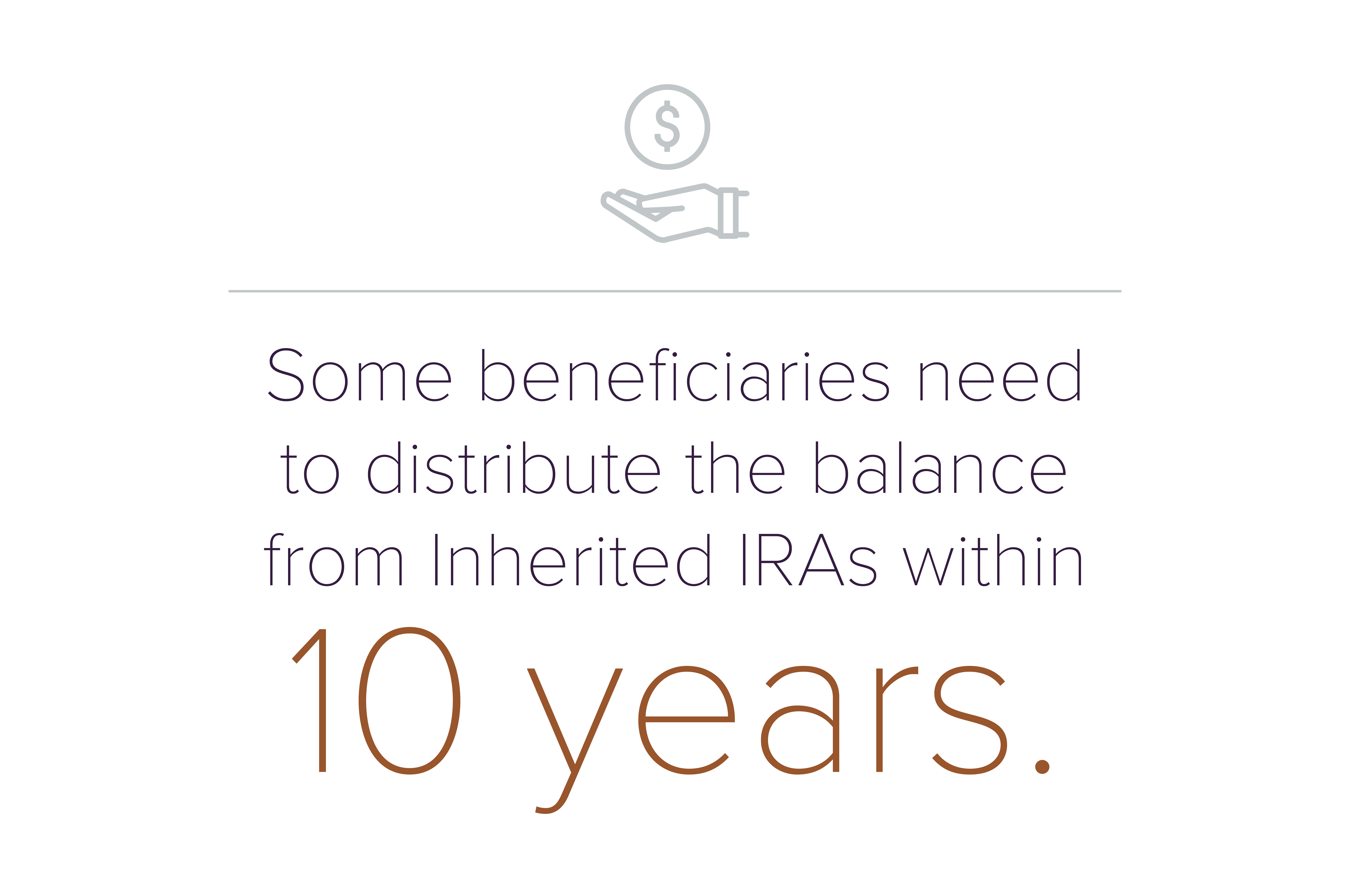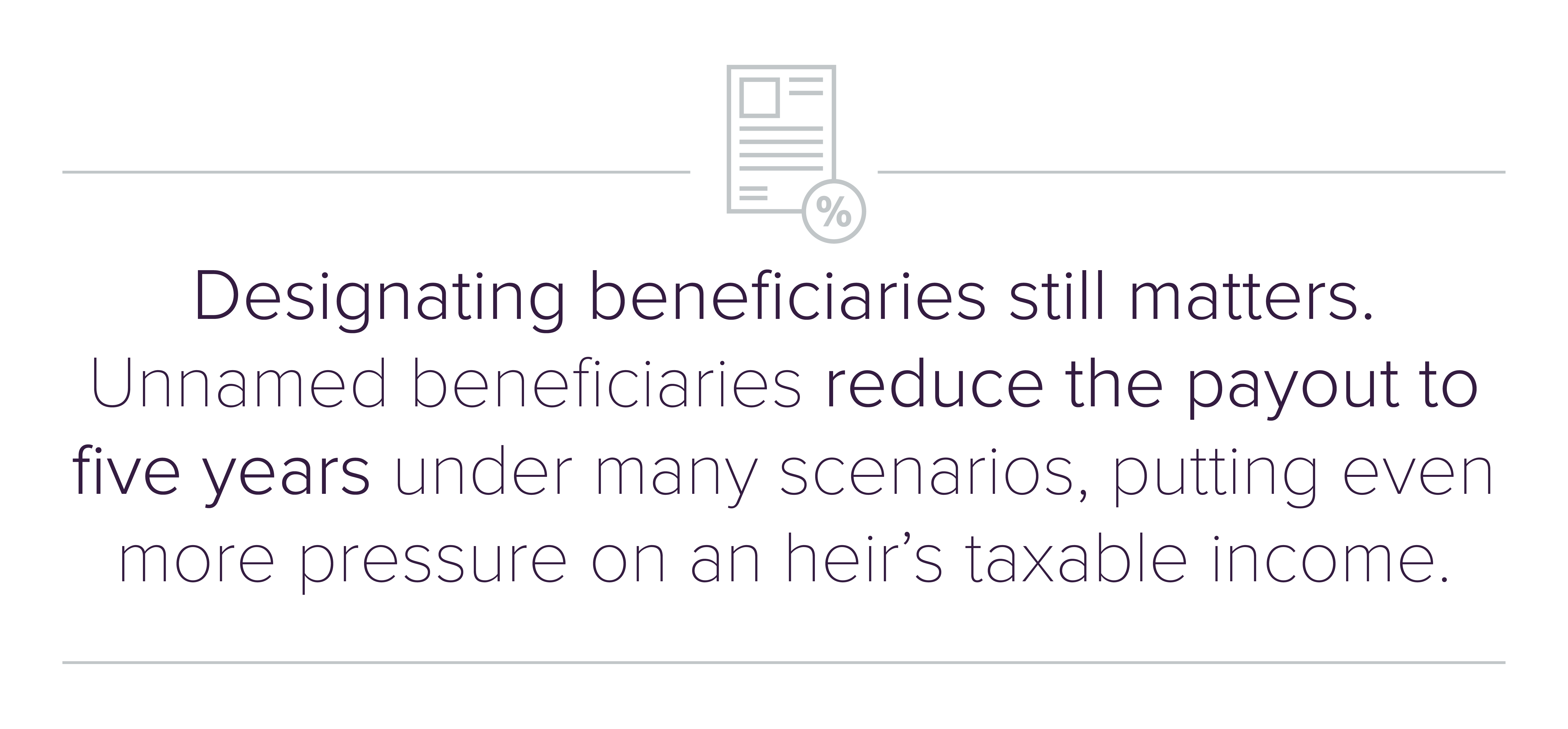The Setting Every Community Up for Retirement Enhancement Act of 2019, or SECURE Act, transformed the landscape of IRA planning. In particular, significant shifts in the required minimum distribution rules for IRAs and qualified retirement plans are now in effect.

Beneficiary classification
The SECURE ACT significantly changed the amount of time that some heirs have to take distributions from an inherited IRA, plus created a new beneficiary classification. Beneficiaries now fall into three categories, each with their own specific rules for IRA distribution: (New) Eligible Designated Beneficiary, Designated Beneficiary, and Non-Designated Beneficiary.
Eligible Designated Beneficiaries (EBDs) are individuals that fall into one of these five categories:
- The owner’s surviving spouse
- The owner’s child while they are a minor
- A disabled individual
- A chronically ill individual
- Any other individual who is not more than 10 years younger than the deceased IRA owner
Designated Beneficiaries are individuals who do not fall into one of the five categories of individuals classified as an EBD. A Designated Beneficiary must be a living person.
Non-Designated Beneficiaries are nonperson entities such as charities, the original account owner’s estate, and non-qualified (not see-through) trusts.
EBDs have not seen a difference in their required IRA distribution timeframe under the SECURE Act—they can either choose single life expectancy payments or take full distribution within 10 years. Single life expectancy payments are calculated by dividing the balance or total value of a retirement account by the policyholder’s anticipated life expectancy. This option, however, is no longer available to the other groups of beneficiaries, most of whom will now need to distribute the balance from their Inherited IRA within 5 or 10 years, with very few exceptions.
For example
Prior to the SECURE Act, a 40-year-old person who inherited an IRA from a parent would have the option to collect single life expectancy payments. If the same individual inherited that same account today, they would need to have the account depleted in 10 years. Undeniably, the SECURE Act has presented some opportunities for individuals who are willing to do some cash flow planning, but for many, it has significantly shortened the lifespan of an inherited retirement account.

A key takeaway all investors must consider is that designating beneficiaries still matters! If a beneficiary is not named, you could reduce the payout term of the retirement account from 10 years to 5, putting even more pressure on taxable income and reducing the flexibility of planning opportunities.
 Ramifications from the SECURE Act have emphasized the importance of discussion with a tax or financial adviser. We have outlined the major provisions of this Act above, but as you can always expect from Congress, there are additional considerations for beneficiaries of trusts and estates. Please do not hesitate to schedule a consultation if you would like us to assist you and your family navigate regulatory intricacies to help preserve and protect your assets.
Ramifications from the SECURE Act have emphasized the importance of discussion with a tax or financial adviser. We have outlined the major provisions of this Act above, but as you can always expect from Congress, there are additional considerations for beneficiaries of trusts and estates. Please do not hesitate to schedule a consultation if you would like us to assist you and your family navigate regulatory intricacies to help preserve and protect your assets.
Disclosure
© 2021 Sanderson Wealth Management LLC. This information is not intended to be and should not be treated as legal, investment, accounting or tax advice and is for informational purposes only. Readers, including professionals, should under no circumstances rely upon this information as a substitute for their own research or for obtaining specific legal, accounting, or tax advice from their own counsel. All information discussed herein is current as of the date appearing in this material and is subject to change at any time without notice. Opinions expressed are those of the author, do not necessarily reflect the opinions of Sanderson Wealth Management, and are subject to change without notice. The information has been obtained from sources believed to be reliable, but its accuracy and interpretation are not guaranteed.
Let’s talk about your future.
Schedule a consultation to learn more about our investment services.
Filter Blog Posts
SUBJECT
- Investment Consulting (158)
- Financial Planning (142)
- Tax Consulting (44)
- Estate & Generational Wealth Planning (15)
- Firm News (11)
- Lessons Earned (11)
- COVID-19: Market Watch (10)
- Community (4)
- Philanthropy (4)
- Business Succession Planning (3)
- Prosper Financial Wellness (3)
- Ukraine: Market Watch (1)
AUTHOR
- Angelo Goodenough
- C. Michael Bader, Esq., MBA, CPA, CIMA®
- Caleb Jennings, MBA, CFP®, CIMA®, AIF®
- Cameron Radziwon, LSSBB
- Debbie Todaro
- Evan Kraft, CFP®, CRPC®
- James Warner, MBA, CPA, CFP®, CIMA®
- Joe Bartelo, CPA
- John Gullo, MBA, CFA, CFP®, CIMA®
- John Sanderson, CPA, CIMA®
- Justin Sanderson, MBA, CFP®, CIMA®
- Karen Nicpon, CPA
- Phil Frattali, CFA
- Regyna Waterhouse
- Sanderson Wealth Management
- Tim Domino, CPA, CFP®
- Tucker Weppner, CFP®
